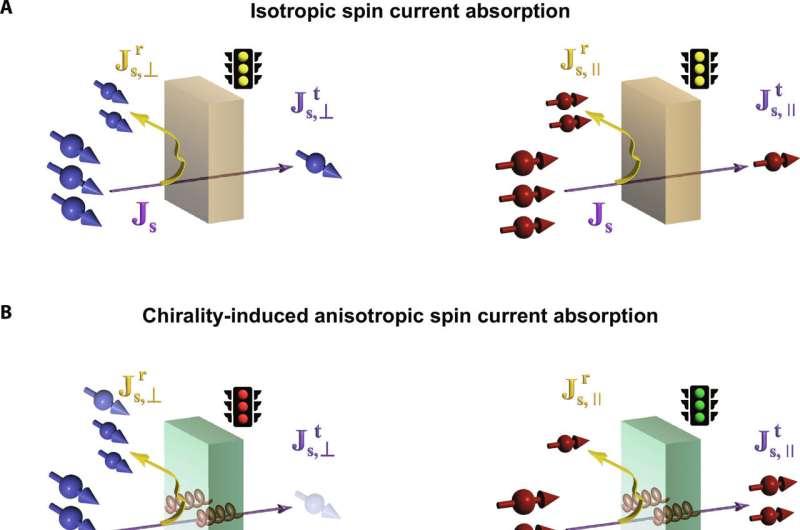This article has been reviewed according to Science X's editorial process and policies. Editors have highlighted the following attributes while ensuring the content's credibility:
fact-checked
peer-reviewed publication
trusted source
proofread
When injecting pure spin into chiral materials, direction matters

Researchers from North Carolina State University and the University of Pittsburgh studied how the spin information of an electron, called a pure spin current, moves through chiral materials. They found that the direction in which the spins are injected into chiral materials affects their ability to pass through them. These chiral "gateways" could be used to design energy-efficient spintronic devices for data storage, communication and computing.
Spintronic devices harness the spin of an electron, rather than its charge, to create current and move information through electronic devices.
"One of the goals in spintronics is to move spin information through a material without also having to move the associated charge, because moving the charge takes more energy—it's why your phone and computer get hot when you use them for a long time," says David Waldeck, professor of chemistry in Pitt's Kenneth P. Dietrich School of Arts and Sciences and co-corresponding author of the work.
Chiral solids are materials that cannot be superimposed on their mirror image—think of your left and right hands, for example. A left-handed glove does not fit on your right hand, and vice-versa. Chirality in spintronic materials allows researchers to control the direction of spin within the material.
"Prior to this work, it was thought that the sense of chirality, or 'handedness,' of a material was very important to how and whether the spin would move through that material," says Dali Sun, associate professor of physics, member of the Organic and Carbon Electronics Lab (ORaCEL) at North Carolina State University and co-corresponding author of the work.
"And when you're moving the whole electron through the material that is still true. But we found that if you inject pure spin into a chiral material, the absorption of spin current strongly depends on the angle between the spin polarization and chiral axis; in other words, whether the spin polarization is aligned parallel or perpendicular to the chiral axis."
"We used two different approaches, microwave particle excitation and ultrafast laser heating, to inject pure spin into the selected chiral materials in this study, and both approaches gave us the same conclusion," says Jun Liu, associate professor of mechanical and aerospace engineering, member of ORaCEL at NC State and co-corresponding author of the work.
"The chiral materials we chose are two chiral cobalt oxide thin films, each with a different chirality, or 'handedness,'" Liu says. "Non-chiral cobalt oxide thin films are commonly used in modern electronics."
When the team injected pure spin aligned perpendicular to the material's chiral axis, they noted that the spin did not travel through the material. However, when the pure spin was aligned either parallel or anti-parallel to the chiral axis, its absorption, or ability to pass through the material, improved by 3000%.
"Since spin can only pass through these chiral materials in one direction, this could enable us to design chiral gateways for use in electronic devices," Sun says. "And this work also challenges some of what we thought we knew about chiral materials and spin, which is something we want to explore further."
The work appears in Science Advances. NC State postdoctoral researcher Rui Sun, NC State graduate student Ziqi Wang, and University of Pittsburgh Research Assistant Professor Brian Bloom are co-first authors.
More information: Rui Sun et al, Colossal anisotropic absorption of spin currents induced by chirality, Science Advances (2024). DOI: 10.1126/sciadv.adn3240
Journal information: Science Advances
Provided by North Carolina State University




















